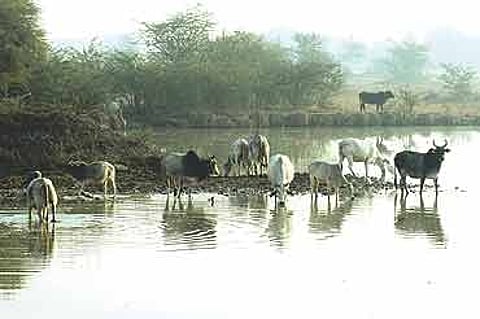Besides the 27 mammal species, including a lone tigress, the water crisis has impacted the socio-economy of this small town. Forty hotels and lodges depend on the park's legendary birding seasons. "Everybody has been leaving angry and disappointed," says an official at the ITDC Hotel Ashok. At the Birder's Inn, weekenders have cancelled their second night stay and owner Tirath Singh has advised his overseas clients against making their annual 15-day visit. Says a park guide: "People abuse us for running a gaushala (cowshed). One couple said they could have saved petrol by going to Delhi Zoo, which is also home to migratory birds."
The scientific community too is worried. "The situation is critical," says Dr Lalitha Vijayan, an expert on KNP's ecology. A senior principal scientist at the Coimbatore-based Salim Ali Centre for Ornithology and Natural History (SACON), Vijayan, who also oversees their Bharatpur field station, asserts: "KNP is a freshwater wetland, entirely dependent on the water from Panchana, which brings 25-65 million fish fry—the food of colonial nesting birds.This year, the pumping of tubewell water, which doesn't have fish fry, has harmed the aquatic vegetation and the entire ecology of this wetland."
Yet with delayed monsoon, park director K.C. Arun Prasad was forced to flood the canal area with well water. His rationale: "Bharatpur's greatest wildlife value is its July heronry, when 15 species of storks, herons and cormorants nest by the thousands." Each year, preceding this season of spectacular activity, bird pairs make a parenting choice based on food and water supply. By late July, beguiled by the appearance of water, a small number of 1,000 birds nested and bred.
"But when the snake birds, darters and cormorants realised the water was coming from the earth rather than the clouds, they deserted their nests by August 2004," says Harsh Vardhan, honorary secretary, TWSI. Some birds like the Indian shag displayed incredible protective natural instincts. Says Bholu Abrar Khan, veteran forester in KNP: "The Indian shag usually lays about five eggs; this year it only laid a single egg, perceiving that food was in short supply." Wild ducks made their winter homes in neighbouring fields and unprotected areas, where their fate is uncertain. Meanwhile, geese grazed on crops and antagonised farmers.
Bharatpur is also a wintering ground for generations of sociable plovers, who breed in Kazakhstan. This year, a global alarm has gone out for this species, whose numbers are down to 200 breeding pairs. On January 9, Grewal, on behalf of the Oriental Bird Club and the BNHS, initiated a plover survey. So far, they have found only seven sociable plovers in the park. This makes it one of the rarest birds in India.
One of Prasad's major concerns is that KNP's wetland character is being transformed by the invasion of vilayati babool (Prosopis juliflora), a plant without any wildlife value, which becomes a strong coloniser during dry periods. Its spread is confirmed by satellite images taken by the Indian Space and Research Organisation (ISRO). While officials are making all efforts to clear the plant, it can only be forced out by flooding.
Other indications of rising aridity are the growth of pseudo-raphis, the re-appearance of khus or vetiver after 10 years and the slow decline of the kadam trees. Recalls a senior forest guard: "When Indira Gandhi came here with Sanjay and Rajiv, we requested money for a wall and got 18 lakh to build a six-foot boundary. Last year, we got 1-2 lakh for a 2-foot wall that the cows can walk over." Today 5,000 cattle are consuming most of the water being pumped out of the wells. For cow-riddance the park has a measly budget of Rs 1 lakh and the service of four tempos. And should a cow die in custody, the director could be jailed for cruelty to animals.
Worst hit this season are the rickshaw pullers and guides like 41-year-old Partap Singh, for whom finger-pointing has been a pleasurable source of income. A class VII dropout, Partap is now a multilingual expert who can identify any feathered being in Bharatpur in Francais, Deutsche, "little bit in Dutch and thoda Spanish and always by correct biological name."
His best years were in the '80s, when foreign visitors would swoon over the Siberian crane and the black-necked storks, pressing fat tips in his hands for showing them aspects of paradise. Today, as he sees desperate guides pointing out a spotted owlet to day-trippers, who whoop at the bird and holler ullu-ullu (owl-owl), he says: "Such people don't deserve to see our treasures, but then, everyone has to make some money. "
Protest movements are gathering force. In Jaipur, on January 12 and 13, during the annual bird fair at Man Sagar Lake, Harsh Vardhan launched a citizen's initiative called the 'Save the Keoladeo National Park'.Grateful to Vasundhararaje who had finally intervened in September for the release of water from Panchana, Vardhan says: "Since her decision was thwarted by her own cabinet colleagues, we are fanning out for an agitation to save this site." His aim is to collect 10,000 signatures on a petition that will be sent to the centrally empowered committee of the Supreme Court, headed by Jai Krishna, former secretary, Ministry of Environment and Forests.
But with the summer all set to blaze on this semi-arid park, the fate of 350 bird and 27 animal species and 21 newly-discovered nematodes (worms), who form part of KNP's micro-ecology, hangs in the balance. It was in the 1700s when Maharaja Suraj Mal created this man-made paradise. Today, some 250 years on, it looks like some lesser men and petty politicians in Bharatpur are all set to destroy one of South Asia's most beautiful birdlands. Ensuring that we as a people will get the crows we deserve.
Flight From Paradise
With the state government not releasing water, India's best bird haven is a barren wasteland

Published At:
Tags